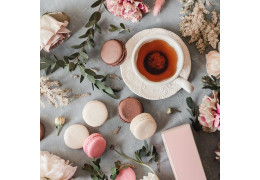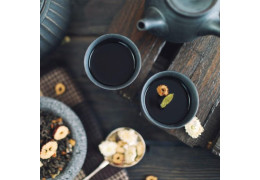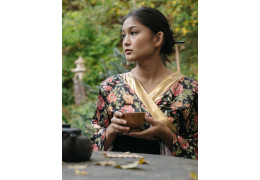History and flavour of Indian black teas
Under the influence of the British Empire, India began producing tea in the 19th century. Today, it is the second largest tea-producing country behind China. There are numerous plantations, notably in Assam, Darjeeling and Nilgiri. Land of black tea and Masala Chai, each region reveals a unique Indian tea. Find out more.
Black tea plantations in the Assam region
Assam remains India's largest producer of black teas. With their full-bodied taste, these teas have been delighting tea lovers for over two centuries.
History of Assam plantations
In the 19th century, tea became increasingly popular in the Western world. Growing demand prompted the British Empire to emancipate itself from the Chinese trade. As a result, numerous plantations sprang up in India. In the 1820s, a variety of tea plant specific to Assam was discovered: Camellia sinensis var. assamica. The infusion of this Indian tea was an immediate success. This marked the beginning of gardens in the region and of large-scale black tea production.
Assam black tea around the world
Today, Assam produces over 50% of India's tea. Plantations stretch across the entire region. The region is ideal for growing the Assamica tea plant:
- heavy rainfall ;
- heat ;
- cultivation at low altitude, close to sea level;
- fertile soil.
The result is a high production of around 600 tonnes of loose leaf per year. Assam black tea is consumed locally and exported. In France, it is sold loose and in recipes or "blends".
Taste of Assam black tea infusion
The infusion of Assam tea is invigorating and full-bodied, with a powerful aroma and strong bitterness. This Indian tea is ideal for the start of the day, with a splash of milk. It is a regular ingredient in blends such as breakfast tea. In India, it is also used to prepare hot spiced drinks.
Darjeeling: the great Indian infusion
Ever anxious to reduce the tea trade with China, British colonists began planting Darjeeling gardens around 1840. Today, Darjeeling is certainly the best-known Indian tea in France.
Darjeeling: plantations unique in the world
It's not the Indian tea plant that's used in the plantations, but the hardier Chinese Camellia sinensis . Because of the contrasting climate in northern India, the leaves grow slowly and in small quantities. This makes the tea leaf tender and rich in flavor. Darjeeling plantations are also the target of a pest: Edwardsiana flavescens. By nibbling the leaves, the insect causes a biochemical phenomenon that changes the aromatic profile of Darjeeling black tea, giving it muscatel notes.
A recipe copied, a great black tea unequalled
The special characteristics of the Darjeeling gardens produce one of India's finest teas, with the reputation of a grand cru. It's even known as the"Champagne of tea". This popularity has led to the appearance of counterfeit black teas. India countered by creating the Darjeeling PGI. Today, there are barely a hundred gardens certified to produce Darjeeling black teas.
A muscatel-flavoured infusion for tea time
Darjeeling black tea is generally very delicate and aromatic, with dominant notes of muscatel. As a result, cups of Darjeeling tea are ideal for tea time. But there are four annual harvests of Indian tea, each with its own distinct flavour. The infusion of the first flush is light, not very bitter, with floral aromas. The second flush brings fruitier notes. Leaves from the latest harvests have a more full-bodied, woody taste.
Nilgiri leaves for versatile drinks
Little known in France, Nilgiri black teas are produced in large quantities and consumed mainly in India. The Nilgiris, or Blue Mountains, are part of the southern region of India. High-altitude cultivation is perfectly suited to the needs of the tea plant. The mild winter climate enables the leaves to be harvested all year round.
History of Nilgiri black tea production
In the 20th century, strong demand for Indian tea prompted producers to industrialize. Mechanization, known as CTC, had a negative impact on tea quality. Nevertheless, some craftsmen are turning back the clock and attempting to rewrite the history of Nilgiri tea. Some are returning to more traditional methods and organic farming.
Drinks with Nilgiri black tea: Masala chai and blends
As for the taste of this Indian tea, it has a strong astringency. It has a powerful aromatic profile with hints of spice. Nilgiri black tea is ideal for breakfast and blends perfectly with breakfast tea blends. In India, it is the main black tea used in the recipe for masala chai.
Preparing the Indian drink: masala chai
It's impossible to talk about Indian tea without mentioning the traditional Indian beverage. It goes by many names: chai latte, masala chai, chai tea or simply chai. The recipe includes :
- indian black tea ;
- milk instead of water;
- cooking spices ;
- sugar.
For gourmet cups, we prefer a full-bodied, bitter black tea such as Assam or Nilgiri. The leaves are infused in hot milk, not boiling water. To this, sugar and the desired spices are added: cinnamon, cardamom, ginger, cloves, cumin seeds or other Indian spices. Let yourself be tempted by a bag of organic Indian loose tea or a typical Indian Ayurvedic herbal tea. Discover our fine Darjeeling and Assam teas for your tea time.




